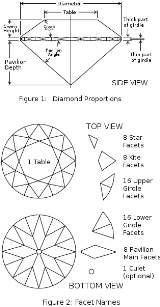
Culet
Encyclopedia
In gemology
, a culet is a flat face on the bottom of a gemstone
.
 During the 14th century, after the adoption of the table cut
During the 14th century, after the adoption of the table cut
, a further facet
was added to the bottom of the cut parallel to the surface of the table. The term used for these bottom facets derives from the latin
word for bottom
, culus.
The culet is added largely to protect the integrity of the gemstone. On a diamond, the cleavage plane runs parallel
to the octahedral
faces, and so any damage to the tip of the diamond could cause a split up the entire length of the pavilion
. With other gemstones that are not subject to cleavage
, the culet is added to protect the fragility of the pointed tip.
The culet has remained optional on many diamond cut
s up to the present day, and was omitted from Marcel Tolkowsky
's original designs for the round brilliant
diamond cut in 1919. Nonetheless, culet facets are common on modern brilliant cut diamonds.
Gemology
Gemology or gemmology is the science dealing with natural and artificial gems and gemstones. It is considered a geoscience and a branch of mineralogy...
, a culet is a flat face on the bottom of a gemstone
Gemstone
A gemstone or gem is a piece of mineral, which, in cut and polished form, is used to make jewelry or other adornments...
.

Diamond cutting
Diamond cutting is the art, skill and, increasingly, science of changing a diamond from a rough stone into a faceted gem. Cutting diamond requires specialized knowledge, tools, equipment, and techniques because of its extreme difficulty....
, a further facet
Facet
Facets are flat faces on geometric shapes. The organization of naturally occurring facets was key to early developments in crystallography, since they reflect the underlying symmetry of the crystal structure...
was added to the bottom of the cut parallel to the surface of the table. The term used for these bottom facets derives from the latin
Latin
Latin is an Italic language originally spoken in Latium and Ancient Rome. It, along with most European languages, is a descendant of the ancient Proto-Indo-European language. Although it is considered a dead language, a number of scholars and members of the Christian clergy speak it fluently, and...
word for bottom
Bottom
Bottom normally means the base, or the lowest point, of an object or geographic feature. It can also refer to:* Buttocks, portions of the anatomy on the posterior of the pelvic region of apes and humans, and many other bipeds or quadrupeds...
, culus.
The culet is added largely to protect the integrity of the gemstone. On a diamond, the cleavage plane runs parallel
Parallel (geometry)
Parallelism is a term in geometry and in everyday life that refers to a property in Euclidean space of two or more lines or planes, or a combination of these. The assumed existence and properties of parallel lines are the basis of Euclid's parallel postulate. Two lines in a plane that do not...
to the octahedral
Octahedron
In geometry, an octahedron is a polyhedron with eight faces. A regular octahedron is a Platonic solid composed of eight equilateral triangles, four of which meet at each vertex....
faces, and so any damage to the tip of the diamond could cause a split up the entire length of the pavilion
Pavilion (structure)
In architecture a pavilion has two main meanings.-Free-standing structure:Pavilion may refer to a free-standing structure sited a short distance from a main residence, whose architecture makes it an object of pleasure. Large or small, there is usually a connection with relaxation and pleasure in...
. With other gemstones that are not subject to cleavage
Cleavage (crystal)
Cleavage, in mineralogy, is the tendency of crystalline materials to split along definite crystallographic structural planes. These planes of relative weakness are a result of the regular locations of atoms and ions in the crystal, which create smooth repeating surfaces that are visible both in the...
, the culet is added to protect the fragility of the pointed tip.
The culet has remained optional on many diamond cut
Diamond cut
A diamond cut is a style or design guide used when shaping a diamond for polishing such as the brilliant cut. Cut does not refer to shape , but the symmetry, proportioning and polish of a diamond...
s up to the present day, and was omitted from Marcel Tolkowsky
Marcel Tolkowsky
Marcel Tolkowsky was a member of a Belgian family of diamond cutters and an engineer by education. He is generally acknowledged as the father of the modern round brilliant diamond cut...
's original designs for the round brilliant
Brilliant (diamond cut)
A brilliant is a diamond or other gemstone, cut in a particular form with numerous facets so as to have exceptional brilliance. The shape resembles that of a cone and provides maximized light return through the top of the diamond....
diamond cut in 1919. Nonetheless, culet facets are common on modern brilliant cut diamonds.

